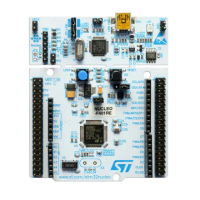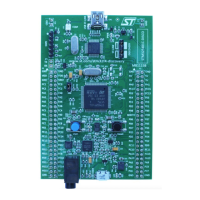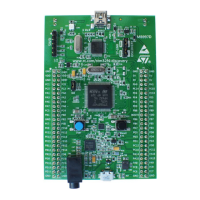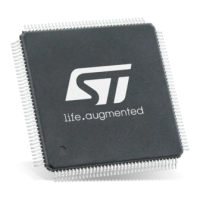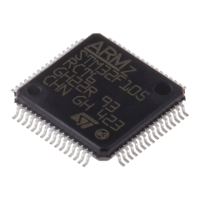USB on-the-go full-speed (OTG_FS) RM0402
1094/1163 RM0402 Rev 6
transfers. The deeper the queue (along with sufficient FIFO size), the more often the
core is able to pipeline non-periodic transfers. If the queue size is small, the core is
able to put in new requests only when the queue space is freed up.
The core’s periodic request queue depth is critical to perform periodic transfers as
scheduled. Select the periodic queue depth, based on the number of periodic transfers
scheduled in a microframe. If the periodic request queue depth is smaller than the
periodic transfers scheduled in a microframe, a frame overrun condition occurs.
• Handling babble conditions
OTG_FS controller handles two cases of babble: packet babble and port babble.
Packet babble occurs if the device sends more data than the maximum packet size for
the channel. Port babble occurs if the core continues to receive data from the device at
EOF2 (the end of frame 2, which is very close to SOF).
When OTG_FS controller detects a packet babble, it stops writing data into the Rx
buffer and waits for the end of packet (EOP). When it detects an EOP, it flushes already
written data in the Rx buffer and generates a Babble interrupt to the application.
When OTG_FS controller detects a port babble, it flushes the Rx FIFO and disables the
port. The core then generates a port disabled interrupt (HPRTINT in OTG_GINTSTS,
PENCHNG in OTG_HPRT). On receiving this interrupt, the application must determine
that this is not due to an overcurrent condition (another cause of the port disabled
interrupt) by checking POCA in OTG_HPRT, then perform a soft reset. The core does
not send any more tokens after it has detected a port babble condition.
29.16.5 Device programming model
Endpoint initialization on USB reset
1. Set the NAK bit for all OUT endpoints
– SNAK = 1 in OTG_DOEPCTLx (for all OUT endpoints)
2. Unmask the following interrupt bits
– INEP0 = 1 in OTG_DAINTMSK (control 0 IN endpoint)
– OUTEP0 = 1 in OTG_DAINTMSK (control 0 OUT endpoint)
– STUPM = 1 in OTG_DOEPMSK
– XFRCM = 1 in OTG_DOEPMSK
– XFRCM = 1 in OTG_DIEPMSK
– TOM = 1 in OTG_DIEPMSK
3. Set up the data FIFO RAM for each of the FIFOs
– Program the OTG_GRXFSIZ register, to be able to receive control OUT data and
setup data. If thresholding is not enabled, at a minimum, this must be equal to 1
max packet size of control endpoint 0 + 2 words (for the status of the control OUT
data packet) + 10 words (for setup packets).
– Program the OTG_DIEPTXF0 register (depending on the FIFO number chosen) to
be able to transmit control IN data. At a minimum, this must be equal to 1 max
packet size of control endpoint 0.
4. Program the following fields in the endpoint-specific registers for control OUT endpoint
0 to receive a SETUP packet
– STUPCNT = 3 in OTG_DOEPTSIZ0 (to receive up to 3 back-to-back SETUP
packets)
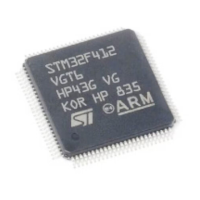
